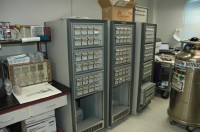From the Current-Argus, Carlsbad (3/12/2013) — Two years ago this week, the world watched in horror as a massive earthquake registering 9.0 on the Richter Scale hit Japan, followed by a tsunami on the country’s east coast, killing thousands of people.
While the loss of life and property was tremendous, it could have been far worse.
The country’s three nuclear reactors at the Fukushima-Daiichi nuclear power plant were crippled by the 45-foot high tsunami wave and the loss of external power caused several explosions and a release of radioactivity over a 10-day period. Fortunately, there was no loss of life at the plant.
As the disaster unfolded, 10,000 miles away, the Carlsbad Environmental Monitoring and Research Center, an independent environmental monitoring laboratory, began monitoring the air for radiation fallout.
Known as CEMRC, the agency is funded by a grant from the Department of Energy Carlsbad Field office and is part of New Mexico State University’s College of Engineering.
Punan Thakur, a CEMRC radio chemist, and her assistant technician Sally Ballard, recalled the work that was conducted at CEMRC, which is located on the campus at New Mexico State University Carlsbad, in tracking radiation in the air.
“As the events unfolded at Fukushima, at CEMRC, we used our ultra-sensitive fixed ambient air radiation monitors for assessing the domestic impact of these releases from the other side of the world,” Thakur said. “The air monitors are part of the CEMRC environmental monitoring program set up primarily to detect possible releases from the nearby Waste Isolation Pilot (WIPP).”
WIPP is a federal nuclear waste repository located about 27 miles east of Carlsbad. Thakur and Ballard said Fukushima-related atmospheric activity was detected in Carlsbad about seven days after the initial atmospheric release occurred in Japan. But what was found in the air was minimal.
According to a 2011 annual report provided by CEMRC, in response to the Fukushima incident, CEMRC accelerated and increased sampling frequency and analysis of the air in and around the WIPP site to confirm that there were no harmful levels of radiation reaching the U.S. from Japan, and to better inform the public about any level of radiation detected.
“Subsequent global circulation models show that the air mass carried radioactive gases and particulate matter along a lengthy and somewhat circuitous path across the northern Pacific, diluting the fallout as it went by approximately 1 million times. As a result, the radiation levels detected in southeastern New Mexico were extremely low; well below any level of public or environmental concern,” Thakur said.
Thakur and Ballard said detecting these very small traces of atmospheric radioactivity and tracing them to Fukushima is a testament to the capabilities of CEMRC to assure local residents that any releases from neighboring nuclear activities will be quickly detected and reported.
They said for several weeks after the severe damage to the Fukushima nuclear reactors, radioactive materials released from the reactors were detected around the world.
They said the sensitivity of modern-day radiation monitoring equipment allows detection of extraordinary small amounts. Thakur noted that humans are exposed to radiation every day. Most comes from natural sources including cosmic radiation, solar radiation and radiation from our planet.
“All living things also contain naturally occurring radioactive elements like potassium and carbon-14, which contribute to background radiation exposure,” Thakur said. “Other common radiation exposure comes from man-made sources such as X-rays, CT scans, smoke detectors and cigarette smoking. The important things that we need to consider in assessing the risk associated with an accident like Fukushima is our baseline risk of developing cancer.”
She said humans have a substantial risk of developing cancer in their lifetime, whether accidently exposed to radiation or not.
Thakur said when it comes to assessing the radiation exposure from Fukushima, the question is: What is the relative magnitude of the increased risk of Fukushima compared to our baseline risk?
“CEMRC’s measurements of the Fukushima radioactivity that reach southeastern New Mexico prove that is exceedingly small, approaching zero,” she said.
Russell Hardy, CEMRC director, said the facility plays an important role in the community by monitoring the air, water and soil around WIPP and in and around Carlsbad.
CEMRC was formed in 1991 and, in 1995, through the donation of land on the south side of NMSU Carlsbad by Bob Light, a former state representative and Carlsbad businessman, the CEMRC research facility was built.
The center is funded through a Department of Energy Financial Assistance grant. It has a total of 40 people working there, 19 of whom are CEMRC and the remainder are from WIPP and Los Alamos National Lab.
“We study and collect data on our air, groundwater, drinking water, the soil and sediments in the river bed,” Hardy said. “We work closely with Los Alamos National Laboratory. We also work with scientists from all over the world. During the Fukushima disaster, our scientists worked with a whole network of scientists from across the nation.”
Hardy said while CEMRC works closely with WIPP’s scientists collecting data and monitoring the environment, CEMRC has more leeway than the federal facility in making the data it collects readily available to the public.
“WIPP is more about compliance with federal regulatory requirements. We are more about information and protecting citizens,” Hardy said. Asked if the federal sequestration has had an impact on the federal grant CEMRC receives, Hardy said CEMRC was asked submit to the Department of Energy a slimmed down budget.
He said he is unsure if there will be any funding cuts.
“We cut our budget on the front end instead of the back end,” he said.
By: Stella Davis, Current-Argus staff writer

